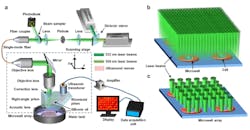For doctors to determine the best treatment for cancer patients, they must know what types of cancer cells they are dealing with, which is not an easy task. Even within the same tumor, for example, cancer cells can differ in their genetics, behavior, and susceptibility to chemotherapy drugs.
Cancer cells are generally much more metabolically active than healthy cells, so some insight into a cancer cell’s behavior and type can be gathered by analyzing its metabolic activity. But getting an accurate assessment of metabolic activity has proven difficult. Several methods, including position emission tomography (or PET) scans, fluorescent dyes, and contrast agents have been used, but each is limited it is usefulness.
According to a medical and electrical engineering professor at Caltech, Lihong Wang, photoacoustic microscopy (PAM) would help in identifying cancer cells. It uses a laser to induce ultrasonic vibrations in samples. Those vibrations can image cells, blood vessels, and tissues. Wang is using PAM to improve an existing technology for measuring cells’ oxygen-consumption rate (OCR).
Researchers developed this photoacoustic microscopy apparatus for imaging the metabolic rates of cancer cells. This data let oncologists identify the various types of cancer cells in a tumor and devise an appropriate treatment. (Credit: Caltech)
OCR takes many cancer cells, each in a container filled with blood. Cells with higher metabolisms use up more oxygen and lower the blood oxygen level, a process monitored by small oxygen sensors placed in each container. This method, like others mentioned, has weaknesses. To get a meaningful sample size of metabolic data for cancer cells would require researchers to use thousands of containers and sensors. Additionally, sensors in the containers alter the cells’ metabolic rates, making the collected data inaccurate.
Wang's improved version does away with the oxygen sensors and instead uses PAM to measure oxygen level in each container. He does this with a laser tuned to a wavelength that hemoglobin in blood absorbs and converts into vibrational energy—i.e., sound. As a hemoglobin molecule becomes oxygenated, its ability to absorb light at that wavelength changes. Thus, Wang can determine how oxygenated a sample of blood is by “listening” to the sound it makes when illuminated by the laser. He calls this single-cell metabolic photoacoustic microscopy, or SCM-PAM.
SCM-PAM represents a huge improvement in the ability to assess the OCR of cancer cells, according to Wang. Using individual oxygen sensors to measure OCR limited researchers to analyzing roughly 30 cancer cells every 15 minutes. Wang’s SCM-PAM improves that by two orders of magnitude and lets researchers analyze around 3,000 cells in about 15 minutes.


